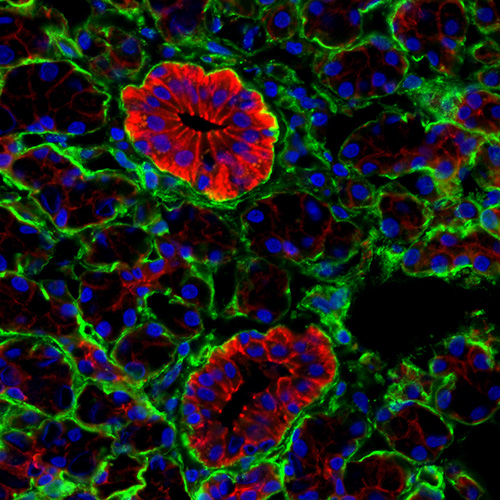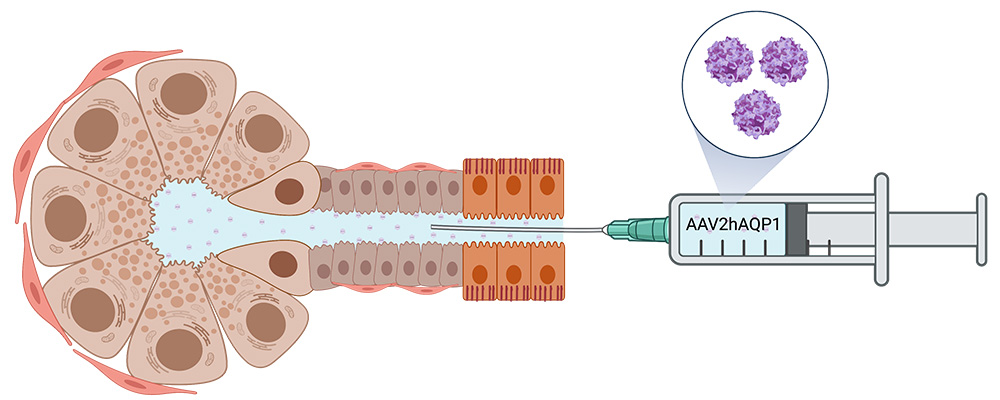The quest to treat and cure xerostomia
When a person’s salivary glands do not produce enough saliva to keep the mouth wet, that condition is called xerostomia. It can make chewing, swallowing and talking difficult and increase the risk of tooth decay. Disease, medications, cancer therapies and nerve damage are all possible causes of xerostomia.
Blake Warner is chief of the Salivary Disorders Unit at the National Institute of Dental and Craniofacial Research, National Institutes of Health. His lab is working on using viral vectors to reengineer the salivary gland with an unregulated water channel as a way to treat xerostomia. This interview has been edited.
How do you administer gene therapy to improve saliva production?

Radiation therapy for head and neck cancer can damage the salivary glands, causing problems such as sticky mucus.
Within the salivary gland beyond the duct is an acinus with cells that secrete water and proteins into the lumen. Other cells around the exterior squeeze the gland. All this happens at the behest of signaling molecules, called acetylcholine, or Ach, initiated at the muscarinic acetylcholine receptors, or M3R.
If we could get inside the gland, could we restore diminished function? Radiation kills cells within the salivary gland. The apoptotic cells and stress cells may produce antigens that induce an immune response. All this leads to a decreased expression of the water channel protein aquaporin-5, or AQP5, and less water — less filtrate from the blood to produce saliva.
We had a hypothesis that we could reengineer the salivary gland if we could put in an unregulated water channel.
We did this with mice by radiating them, cannulating the gland and introducing an adenovirus expressing AQP1. We got a robust and rapid increase in water flow, but it didn’t last long because it is an adenovirus and is very antigenic ─ triggering a massive immune response.
Jay Chiorini, my basic-science research mentor, developed a clone and characterized several important adeno-associated viral vectors that are less antigenic and more stealth-like. They do not induce a massive immune response. Tested on pigs, these adeno-associated viruses carrying AQP1 have achieved long-term transduction.
You can put a straw into the parotid gland duct, and then, using a syringe, you can push that vector up into the gland. The vector can then transduce any acinus inductor cells it touches. The procedure is totally atraumatic.

Have any other drugs in clinical trials shown promising results for dry mouth syndrome?
I am currently testing tofacitinib, a Janus kinase inhibitor that should mitigate some pathogenic inflammatory signaling in the gland, in an open and enrolling clinical trial. Other investigators have studied drugs, such as iscalimab and dazodalibep, that target B cell and T cell co-stimulation, and they have met their primary end points in Sjögren’s disease (an autoimmune disorder that causes dry eyes and mouth). Ibrutinib, a Bruton’s tyrosine inhibitor that targets B cells, seems to work effectively.
With diseases like this, there’s never really a perfect drug, only a drug that is approved and available. We will be in that phase with Sjögren’s for a long time.
What motivated you to specialize in dry mouth?
During my residency in an oral medicine clinic, I first saw patients with true xerostomia ─ recurrent infections of the mouth and cavities that patients couldn’t control. I found that many drugs had been tried in well-designed clinical trials and nothing was effective.
I realized someone needed to study this as both a pathologist and a clinical investigator, looking not just at the patient in the chair but also at the patient’s tissue under the microscope.
My integrated research laboratory takes specimens of salivary gland tissues, and within 10 minutes, we start to process them. When I tell a patient I need to do a biopsy, I can say that I’m not only going to give them a clinical diagnosis, but I will also use their tissue to study the disease and look for drugs that will help treat the inflammation that is driving the damage to their organs.
Clinical research is a partnership with patients. Part of that is risk mitigation. I feel like I have been successful in that because I am honest and straightforward with my patients.
The other part of my job is service. I get to do research, but I have all these other experts at my disposal: rheumatologists, physician’s assistants, experts in salivary gland ultrasonography, ophthalmologists, dry eye experts and oral pathologists. There are very few places where a patient with Sjögren's disease can receive all of those specialist workups. And there is no cost to the patient. We couldn’t study it effectively without this infrastructure in place.
Enjoy reading ASBMB Today?
Become a member to receive the print edition four times a year and the digital edition monthly.
Learn moreGet the latest from ASBMB Today
Enter your email address, and we’ll send you a weekly email with recent articles, interviews and more.
Latest in Science
Science highlights or most popular articles

Targeting Toxoplasma parasites and their protein accomplices
Researchers identify that a Toxoplasma gondii enzyme drives parasite's survival. Read more about this recent study from the Journal of Lipid Research.

Scavenger protein receptor aids the transport of lipoproteins
Scientists elucidated how two major splice variants of scavenger receptors affect cellular localization in endothelial cells. Read more about this recent study from the Journal of Lipid Research.

Fat cells are a culprit in osteoporosis
Scientists reveal that lipid transfer from bone marrow adipocytes to osteoblasts impairs bone formation by downregulating osteogenic proteins and inducing ferroptosis. Read more about this recent study from the Journal of Lipid Research.

Unraveling oncogenesis: What makes cancer tick?
Learn about the ASBMB 2025 symposium on oncogenic hubs: chromatin regulatory and transcriptional complexes in cancer.

Exploring lipid metabolism: A journey through time and innovation
Recent lipid metabolism research has unveiled critical insights into lipid–protein interactions, offering potential therapeutic targets for metabolic and neurodegenerative diseases. Check out the latest in lipid science at the ASBMB annual meeting.

Melissa Moore to speak at ASBMB 2025
Richard Silverman and Melissa Moore are the featured speakers at the ASBMB annual meeting to be held April 12-15 in Chicago.

